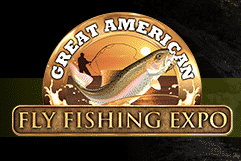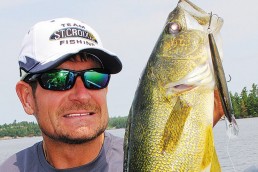Falling Leaves mean Rising Action in the Heartland
On one bank, the rising sun back-lighted the foliage, making trees appear to burn like Moses’ Biblical bush while soft rays landing on the far shoreline ignited the leaves into blazing orange and scarlet gems.
On this crisp October morning, the guide scrutinized his electronics as he idled into the cove through wisps of fog rising from the chilled water. Finding the right spot, he tossed a marker into the water.
“This is it,” said Steve Brasfield, a crappie pro and guide from Milan, Tenn. “In the fall, most often, we vertically jig around structure that we put out ourselves.”
Steve and Dale Oliver, his tournament partner from Milan, dropped jigs sweetened with live minnows into the water. Near the bottom, oak planks created an artificial underwater forest to attract fish. Before long, a fat crappie took the bait.
“I like to fish Kentucky Lake more in the fall than in the spring because the weather is more consistent and the fish really bite well,” Brasfield remarked. “The fish have been feeding and growing all summer, so we catch some big fish in the fall. This system has good numbers and sizes. I’ve caught some crappie over 3 pounds on this lake.”
From southeast of Paducah, Ky., to near New Johnsonville, Tenn., Kentucky Lake runs for 184 miles along the Tennessee River. The largest artificial lake by surface area east of the Mississippi River, the reservoir created in 1944 spreads across 160,309 acres. It offers anglers more than 2,064 shoreline miles, more than twice as long as the California coastline.
The lake connects to the 57,900-acre Lake Barkley through a 1.7-mile long navigation canal. Slightly younger and smaller, Lake Barkley dates to 1964 and runs for about 134 miles along the Cumberland River between Princeton, Ky., and Dover, Tenn. Lake Barkley generally parallels Kentucky Lake and offers anglers another 1,004 shoreline miles. If flattened into a straight line, the combined shoreline from the two lakes and associated waters would stretch almost from Boston to San Francisco.
Both lakes can provide outstanding crappie fishing in the fall. In October 2011, Tim Ridley of McKenzie, Tenn., and Scott Watson of Paris, Tenn., won the Cabela’s Crappie USA Classic, held on Kentucky Lake out of Paris Landing State Park near Buchanan, Tenn. The pair brought in two consecutive seven-fish daily tournament limits weighing 24.11 pounds for a 1.72-pound average. Catching more than 100 fish each day, they anchored their catch with a 2.17-pounder, the second largest crappie weighed during the tournament.
Ridley and Watson vertically fished manmade cover about 14 to 20 feet deep in bays near the Kentucky-Tennessee line. They caught fish on orange and chartreuse, yellow and chartreuse or white and glow Southern Pro jigs tipped with Berkley PowerBait Crappie Nibbles.
“These lakes have been excellent crappie waters ever since they were created,” explained Darrel Van Vactor, the Crappie USA president and a guide with Van’s Guide Service in Benton, Ky.
“Kentucky and Barkley lakes had poor spawns in 2009 and 2010, but we’ve had a couple good spawns since then. The 2011 season was unreal with the number of fish caught. These lakes have a tremendous population of crappie in the 9.5- to 10.5-inch range. We’re going to see large fish in unheard of numbers for the next few years.”
The lakes contain both black and white crappies. Historically white crappies outnumbered their cousins by about 80 percent to 20 percent, but that flipped in recent years. Now, the lakes contain about 70 percent black crappies, Van Vactor said. Black crappies tend to stay shallower than white crappies. In the fall, look for them in less than 6 feet of water around docks, natural cover and brush piles.
Like many anglers, Brasfield and Oliver create their own fish habitat. They build stake beds, frame beds and brush piles to attract fish. Sometimes, they augment their artificial reefs with brush.
“We build a lot of our own cover, but the lake still has abundant natural cover like old stump fields,” Oliver explained. “To build a stake bed, we drive 1x1s about five feet long into the bottom. A frame bed is an 8-foot by 8-foot box of 1/4-inch by 4-inch oak slats screwed or nailed to 2x4s so that it stands up about 36 to 42 inches off the bottom.”
On the other hand, white crappies prefer slightly deeper water, about 10 to 15 feet deep. Whites frequently move. In the fall, they follow threadfin shad to gorge themselves before the coming winter.
“In the fall, white crappie follow shad back into the bays,” Van Vactor explained. “They use creek channels just like people use highways to travel from the main lake back into the bays. To find fish, follow the creeks off the main channel. The fish may be in the back of the creeks, halfway up the creek or near where the creek hits the main river channel.”
With abundant channels and thousands of artificial reefs created by crappie fishermen, anglers should find good action just about anywhere on the lake. At times, Barkley offers better fishing, but sometimes anglers need to fish Kentucky Lake. Some better places to find slabs include the West Sandy Creek, Country Junction, Springville and New Johnsonville areas.
“Both lakes are just about equal,” Van Vactor said. “In the fall and winter, Barkley is usually a little better. In the spring, Kentucky is usually a little stronger. On Barkley Lake, I recommend the Little River and Hurricane Creek areas about 20 miles south of the dam in Kentucky state waters. On the Kentucky Lake side, I’d fish the Paris Landing area around Eagle Creek or Blood River.”
Visitors find many numerous lodges and parks around both lakes where they can stay. Many people run out of Paris Landing State Park, Nathan Bedford Forrest State Park near Waverly, Tenn., or Lake Barkley State Resort Park near Cadiz, Ky. People can also find lodging and services at Gilbertsville, Ky.
John N. Felsher grew up in Slidell, La., and now lives in Semmes, Ala. He’s a professional freelance writer and photographer with more than 2,100 articles in more than 135 different magazines to his credit. Contact Felsher through his website at JohnNFelsher.com.
For more information…
Steve Brasfield, guide
Milan, Tenn.
731-686-8895
Darrel Van Vactor
Van’s Guide Service
Benton, Ky.
270-395-4204
fishingguideky.com
MWO
SHARE THIS POST
Did you enjoy this post?
You can be among the first to get the latest info on where to go, what to use and how to use it!
John N. Felsher
John N. Felsher grew up in Slidell, La., and now lives in Semmes, Ala. He’s a professional freelance writer and photographer with more than 2,100 articles in more than 135 different magazines to his credit. He also co-hosts a weekly live outdoors radio show every Thursday from noon to 1 p.m. Central Time on WNSP 105.5 FM in Mobile, Ala. and a recorded syndicated show that goes out to multiple stations in Alabama each week. For more info on the syndicated show, see gdomag.com. Contact him at JohnNFelsher.com.





